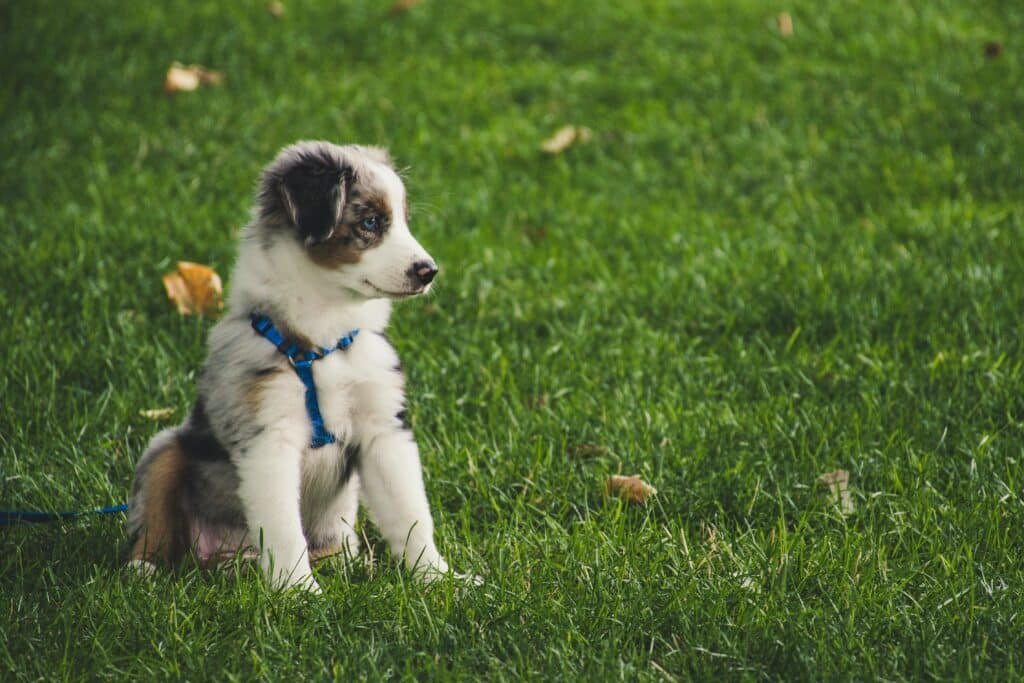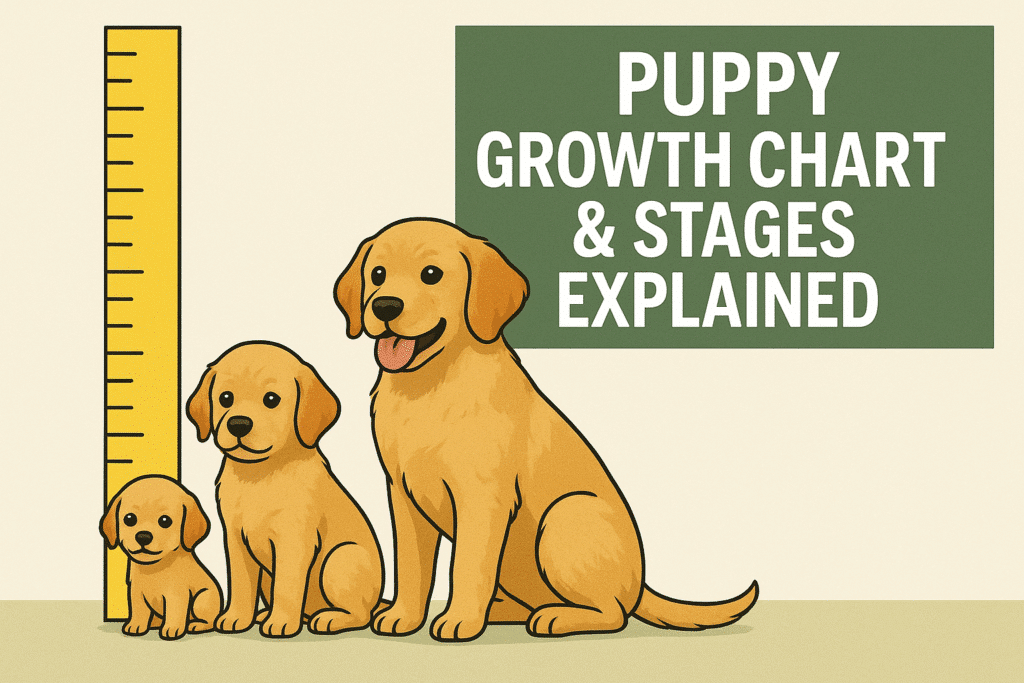Track your puppy’s weight and development with a simple puppy growth chart. Learn each growth stage and get tips for healthy puppy development.
Puppy Growth Chart & Stages Explained – Ultimate Guide for Pet Parents
Everyone wonders how fast puppies grow and how big they will get. A puppy growth chart is a handy tool to predict adult size from puppy age. This guide explains each stage of puppy development – from newborn to adult – in simple steps. We’ll cover weight milestones, key behaviors, and practical tips to keep your puppy happy and healthy as they grow.
Why Use a Puppy Growth Chart?
A puppy growth chart is like a roadmap for your pup’s size and weight. It helps you compare your puppy’s progress to healthy averages for their breed or size. For example, the AKC notes that small breed puppies often reach near adult size by 6–8 months, while very large breeds may continue growing until 18–24 months. By tracking weight each month, you can spot any problems early. If your puppy seems too skinny or too chubby compared to the chart, you’ll know to adjust diet or see the vet.

- Tip: Weigh your puppy weekly on the same scale and note it in a chart. This makes tracking growth easy.
Puppy Development Stages
Understanding what happens at each age helps you care for your puppy. Below are the main stages and what to expect:
1. Neonatal Stage (0–2 Weeks)
Newborn puppies are blind, deaf, and totally dependent on their mother. They sleep most of the time and nurse every few hours. In this stage, the big growth happens: puppies usually double their birth weight by about one week of age. It’s important to keep them warm and check they’re gaining weight.
At about 10 days old, their eyes and ears start to open, and they can sense light and sounds. Until then, they crawl and root around blindly. Their mother licks them to stimulate feeding and elimination.
- Tip: Weigh newborn pups daily. They should gain steadily – roughly double by 7–10 days. If a pup isn’t gaining, consult your vet.
- Tip: Keep puppies and their bedding very clean and warm (around 85–90°F) to prevent illness.
2. Transitional Stage (2–4 Weeks)
Around 2–3 weeks, puppies enter the transitional stage. Their eyes and ears fully open, and their baby teeth start to appear. They gain mobility: wobbling on their legs, wagging their tails, and starting to bark or growl very softly.
From about week 3, puppies begin to wean. You can start offering very soft puppy food or gruel in a shallow dish. By week 4, many pups are drinking water and may eat small amounts of mushy food. By 8 weeks, most puppies are fully weaned and eating solid puppy kibble.
- Tip: Begin gentle socialization now. Handle your puppies often so they get used to people. Introduce mild household sounds (vacuum, talking) gradually to avoid later fearfulness.
- Tip: Provide a shallow water dish. By 4 weeks, puppies should have access to water and supervised hard puppy kibble or wet food.
3. Socialization Stage (4–8 Weeks)
In weeks 4–7, puppies play with littermates and learn doggie manners (like bite inhibition). This is a critical socialization window. Positive experiences with people, new textures (grass, carpet), and gentle handling will help them grow into confident dogs.
By 6–8 weeks, puppies are very active. They may bark, explore, and tussle with each other. Most are fully weaned and ready to find new homes by 8 weeks. At this point, get your puppy to the vet for a health check and start their vaccination series.
- Tip: Expose puppies to a variety of safe experiences now (different people, gentle grooming tools). This builds confidence.
- Tip: Begin simple training around 7–8 weeks. Teach their name and simple commands with treats. Keep sessions short and positive.
4. Juvenile Stage (2–6 Months)
The 2–6 month period is a time of explosive growth! Puppies have boundless energy. You’ll notice they put on weight and size quickly. By 3–4 months, many breeds double the weight they were at 2 months.
Puppies’ baby teeth fall out and are replaced by adult teeth (usually by 5–6 months). Their coordination and strength also improve, so expect lots of running and jumping. Keep play safe – avoid long runs or high-impact play with growing bones.
A balanced, high-quality puppy diet is essential for this stage. Large breeds especially need careful nutrition to protect joints as they grow.
- Tip: Measure meals and feed according to your vet’s or food label recommendations. Growth spurt does not mean free feeding. Preventing overweight is crucial to protect developing bones.
- Tip: Give your puppy plenty of mental exercise too (toys, simple puzzles). The Kong Classic toy, for example, is often recommended to keep active pups busy.
5. Adolescence (6–12 Months)
Between 6–12 months, growth starts to slow for many dogs, but they are still far from full maturity. Small breeds may reach near-adult height by 8–10 months, while larger breeds keep filling out well past their first birthday. The AKC notes small breeds stop growing by ~6-8 months, medium by ~12 months, and giant breeds may not finish until 18–24 months.
During this “teenage” phase, puppies may test boundaries. Continue training, be consistent, and keep up socialization. Physical exercise is still important, but avoid overly strenuous activity or jumping off heights until growth plates close.
- Tip: Check your puppy’s ribs. If you can still feel the growth plates (ribs as “knobs”), expect more growth to come.
- Tip: Continue brushing and gentle exposure to different environments. Adolescence can include a second fear period; stay calm and reassuring.
Puppy Weight Chart by Breed/Size
Puppy growth charts often vary by breed or size category. For example, Pet Buddies Care’s blog has a detailed chart for American Bulldogs: at 4 months a puppy might weigh 30-58 lbs, by 8 months around 56-97 lbs. Such charts help you set realistic goals. In general:
- Small breeds (toy, small) – often near adult size by ~9-12 months; final adult weight usually under ~20 lbs.
- Medium breeds – may finish by 12-18 months; adult weight 20–50 lbs.
- Large breeds (Labrador, Shepherd) – often 75% grown by 6 months and finish by ~1 year.
- Giant breeds (Great Dane, Mastiff) – grow the longest. Many don’t stop growing until over 18 months.
- Tip: Use a breed growth chart if available. For example, an American Bulldog owner found values for each month in a [growth chart] on Pet Buddies Care. Compare your pup’s weight to such ranges but remember individual puppies can vary.
Monitoring Growth & Health
Use your puppy’s vet checkups to track growth. Weigh them at each visit. You can also chart weight at home. A simple rule of thumb: small pups typically gain about 5 ounces per week, while large pups may gain about 2.5 pounds per weekbil-jac.com. Puppies often add ~10–15% of their body weight each day in the early weeks.
If your puppy’s weight gain is too fast, slow it down; too slow, talk to your vet. Overfeeding can lead to joint problems like hip dysplasia later. Always follow feeding guidelines on puppy food.
- Tip: Keep your puppy lean and active. A healthy, lean puppy is better than a chubby puppy, since obesity in puppies can lead to orthopedic issues later.
- Tip: If you see visible ribs, your puppy might still have growing to do. Feeling the rib “knobs” means more height growth is comingakc.org.
Nutrition & Puppy Products
Feeding the right diet fuels healthy growth. Choose a puppy-specific formula (or “all-life-stages” food) that meets AAFCO guidelines. For large breeds, pick food formulated for large-breed puppies to avoid excess calcium. For example, Blue Buffalo Baby BLUE Large Breed Puppy Food (with DHA for brain and eye development) is highly rated by owners (it has a 4.6/5-star Amazon rating).
It’s also important to have the right gear and toys:
- Food & Water Bowls: Sturdy stainless-steel bowls (like AmazonBasics dog bowls) are simple, functional, and affordable. They won’t absorb odors and are easy to clean.
- Toys: For mental stimulation, classic toys like the Kong are a must-have for puppy parents. Stuff it with treats or wet food to keep pups busy and help with teething.
- Chew Toys & Treats: Safe puppy chew toys (rubber or edible) help with teething. (Many owners recommend bully sticks as a digestible chew treat.) Always choose items sized for your puppy’s breed.
- Tip: Limit treats and human table scraps. Stick to vet-approved puppy kibble and chew treats. Your puppy’s diet should mostly be balanced food. Treats are for training and teeth, not weight gain.
For more product ideas and reviews, Pet Buddies Care regularly posts pet gear recommendations. Their blog has a helpful American Bulldog Growth Chart article if your puppy is that breed, showing expected weights for each month.
When Will My Puppy Be Full-Grown?
Every puppy is different. As a rule, small breeds often reach adult size by about 8–10 months. Medium breeds may be fully grown by 12–14 months. Large and giant breeds can take much longer – some Don’t finish growing until 18–24 months old.
Once your puppy’s growth plates close, you’ll mostly see muscle and “filling out” rather than height increases. After the first year, continue to feed high-quality adult food and keep exercising them for muscle tone.
- Tip: Follow your vet’s advice on when to switch to adult food. Typically this is around 11–14 months, depending on breed.
- Tip: Even adult dogs benefit from periodic weight checks. Keep in mind that a dog’s “full-grown” body includes bone plus muscle; a bit of extra muscle or a slight weight change is normal as they become mature.
Conclusion
Understanding the puppy growth chart and stages helps you be the best pet parent. By tracking weight and milestones, you can ensure your puppy is on a healthy path from cuddly newborn to playful adult. Remember to weigh your puppy regularly, feed a proper diet, and provide love and positive training at each stage.



